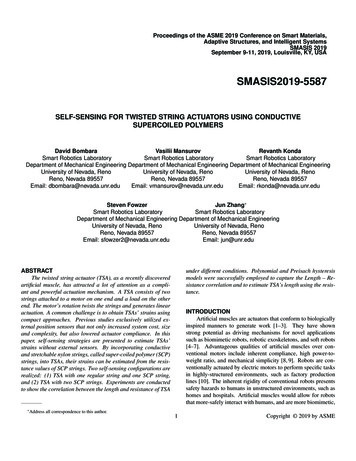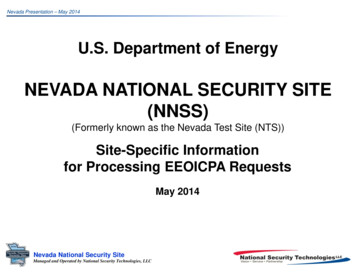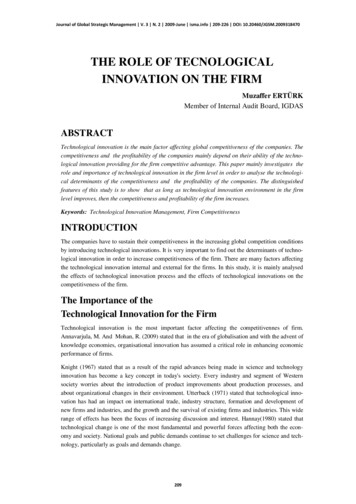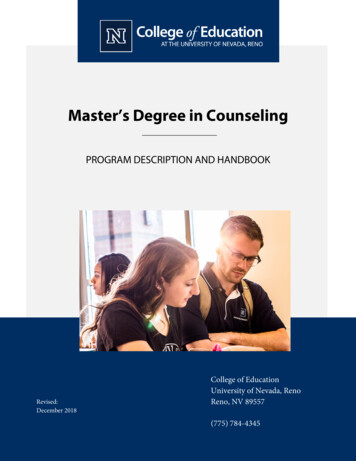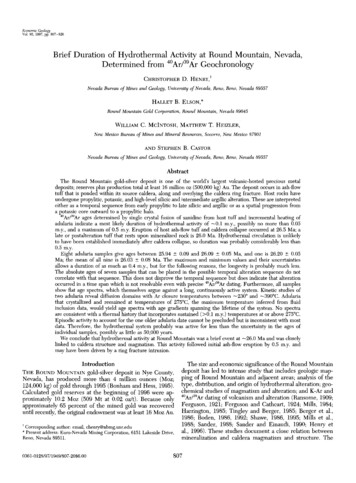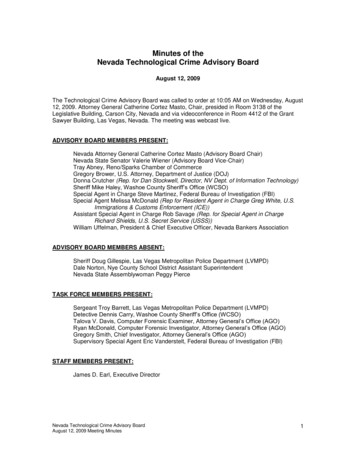
Transcription
Minutes of theNevada Technological Crime Advisory BoardAugust 12, 2009The Technological Crime Advisory Board was called to order at 10:05 AM on Wednesday, August12, 2009. Attorney General Catherine Cortez Masto, Chair, presided in Room 3138 of theLegislative Building, Carson City, Nevada and via videoconference in Room 4412 of the GrantSawyer Building, Las Vegas, Nevada. The meeting was webcast live.ADVISORY BOARD MEMBERS PRESENT:Nevada Attorney General Catherine Cortez Masto (Advisory Board Chair)Nevada State Senator Valerie Wiener (Advisory Board Vice-Chair)Tray Abney, Reno/Sparks Chamber of CommerceGregory Brower, U.S. Attorney, Department of Justice (DOJ)Donna Crutcher (Rep. for Dan Stockwell, Director, NV Dept. of Information Technology)Sheriff Mike Haley, Washoe County Sheriff’s Office (WCSO)Special Agent in Charge Steve Martinez, Federal Bureau of Investigation (FBI)Special Agent Melissa McDonald (Rep for Resident Agent in Charge Greg White, U.S.Immigrations & Customs Enforcement (ICE))Assistant Special Agent in Charge Rob Savage (Rep. for Special Agent in ChargeRichard Shields, U.S. Secret Service (USSS))William Uffelman, President & Chief Executive Officer, Nevada Bankers AssociationADVISORY BOARD MEMBERS ABSENT:Sheriff Doug Gillespie, Las Vegas Metropolitan Police Department (LVMPD)Dale Norton, Nye County School District Assistant SuperintendentNevada State Assemblywoman Peggy PierceTASK FORCE MEMBERS PRESENT:Sergeant Troy Barrett, Las Vegas Metropolitan Police Department (LVMPD)Detective Dennis Carry, Washoe County Sheriff’s Office (WCSO)Talova V. Davis, Computer Forensic Examiner, Attorney General’s Office (AGO)Ryan McDonald, Computer Forensic Investigator, Attorney General’s Office (AGO)Gregory Smith, Chief Investigator, Attorney General’s Office (AGO)Supervisory Special Agent Eric Vanderstelt, Federal Bureau of Investigation (FBI)STAFF MEMBERS PRESENT:James D. Earl, Executive DirectorNevada Technological Crime Advisory BoardAugust 12, 2009 Meeting Minutes1
OTHERS PRESENT:Edie CartrightBrett KandtChris MemmottSean NeahusonP.K. O’NeillBrian O’CallaghanKareen PrenticeLea TauchenGreg WhisenantBob YoungAgenda Item 1 – Call to Order – Verification of QuorumAG CORTEZ MASTO:The meeting is called to order on August 12 at 10:05.A roll call of the Advisory Board verified the presence of a quorum.Agenda Item 2 – Discussion and approval of minutes from October Board Meeting(Discussion/Action Item)AG CORTEZ MASTO:The next agenda item is the discussion and approval of the minutes of our last meeting. Theseminutes have been previously distributed. If there are no changes, I will entertain a motion foradoption.Motion to approve the minutes was made by Mr. Uffelman and seconded by SheriffHaley.Motion to approve the minutes was approved unanimously.Agenda Item 3 – Annual Election of Chair and Vice Chair (NRS 205A.040)(Discussion/Action Item)AG CORTEZ MASTO:The Board’s governing statute requires annual elections to fill the positions of Chair and ViceChair. I will now open the floor for nominations for Chair.Motion to reelect AG Cortez Masto as Chair and Senator Wiener as Vice Chair byacclamation was made by Mr. Uffelman and seconded by Sheriff Haley.Motion was approved unanimously.Agenda Item 4 – Report regarding Task Force Activities. (Discussion/Non-Action Item)AG CORTEZ MASTO:The next item is reports regarding Task Force activities from concerned agencies including theFBI, Las Vegas Metropolitan Police Department (LVMPD), US Secret Service, Attorney General’sOffice, Washoe County Sheriff’s Office (WCSO), and ICE.Nevada Technological Crime Advisory BoardAugust 12, 2009 Meeting Minutes2
Considerable time has passed since our last meeting. I understand that, since that time, the FBIhas undertaken some significant outreach activities and that the Washoe County Sheriff’s Officehas constructed a new facility it is interested in sharing.Are there any reports?SAC MARTINEZ:Madame Chair, if I may, I would like to introduce Supervisory Special Agent Vanderstelt, the headof the southern task force, to report on its activities.SSA VANDERSTELT:Madame Chair, members of the board, good morning and thank you for the opportunity to provideyou with an update on our Task Force activities since the last board meeting.The FBI and Las Vegas Metropolitan Police Department (LVMPD) have been conducting a jointinvestigation into organized criminal groups involved in the fraudulent sale of vehicles over theInternet. A number of indictments and arrests have been made over the past months. Two of themain conspirators have pleaded guilty and were sentenced to between two and four years federalimprisonment and ordered to pay restitution of over 500,000.A man was sentenced to approximately four years for attempting to extort 250,000 from bothHarrah’s and MGM. This was investigated as a computer intrusion matter as the subject led thevictims to believe he had access to their computer networks and could access trade secrets andpersonally identifiable information on employees and guests.Two individuals were indicted in April on charges related to the theft of intellectual property fromIGT Corporation. Multiple search warrants were coordinated and executed in a single dayspanning several time zones, and one of the subjects was arrested in Latvia. This matter wasinvestigated jointly by the FBI, Customs, and Nevada Gaming Enforcement. The Central CriminalPolice Department of the Latvian Ministry of Interior provided significant assistance in the case asdid IGT.Over a dozen individuals have been indicted, arrested, or convicted on federal charges related tochild pornography. Especially notable among these cases – an individual was indicted andconvicted after he attempted to establish a website depicting child pornography. He awaitssentencing. Two subjects were sentenced in separate cases to approximately ten years oncharges of coercion / enticement of a minor. A man was sentenced to more than 24 years behindbars for possession of child pornography and traveling interstate to engage in sex with a 15 yearold boy. The man had a prior sex offense conviction. A woman was sentenced to 10 years inprison on a charge of receipt of child pornography.These are some of the accomplishments I can report that have occurred since our last meeting.As the importance of digital forensics and the scope of work involved in that area is a topic offrequent interest to the board, I’d also like to add that so far this year, our computer forensicexaminers have examined over 1,500 items exceeding 25 TB of information. This amount ofinformation is equivalent to about 5.5 trillion pages of text.In closing, I’d again like to thank the board for extending the opportunity to present this morning.I’m available to answer any questions.ASAC SAVAGE:Recently I attended a global conference in Washington. Representatives from all of the 38Economic Crimes Task Forces, sponsored by the Secret Service were in attendance – some 500participants in all. A number of important topics were discussed including improvements in theinter-agency coordination that is part and parcel of Economic Crimes Task Forces.Nevada Technological Crime Advisory BoardAugust 12, 2009 Meeting Minutes3
AG CORTEZ MASTO:I recently read a report about the presentation of Secretary Napolitano. I understand that shestressed the importance of cooperation among state, local, and federal officials. Could you tell usa little more about that? Also, I understand that a cyber czar has been appointed or is about to beappointed. Is that right, Jim?MR. EARLRecruitment for that position has been going on for some time. It would report both to GeneralJones, the National Security Advisor, and to Larry Summers, who heads the President’s NationalEconomic Council.ASAC SAVAGE:Madam Chair, that is correct. As to your question, one of the main themes of the conference wasinteragency cooperation at all government levels. As we work on a daily basis and shareinformation and investigations, we have an opportunity to come at the problems we confront fromall angles.AG CORTEZ MASTO:Thank you for your comments.SAC MARTINEZ:Madame Chair, if I might add something. I know the focus of dialog on this issue – trying to placea cyber czar – has been, first and foremost, to concentrate on securing government systems.That would include both federal and state systems, but particularly federal systems. We have hada lot of activity in the form of presumed attacks from external enemies. There will be a big push inthat area. This is something that has to be accomplished government wide because everyone isrunning their own networks. They are working very hard to come up with standards and protocolsthat everyone can abide by. This likely will have some input on what comes to be seen as bestpractices for state systems.As far as promoting task forces, this is really nothing new for us or the Secret Service. We haveall been funded to assist as best we can to provide overtime pay, equipment, vehicles and thatsort of thing for task force members that come on board to the task forces we sponsor. We willcontinue to do that. I think we will enjoy adequate funding for these efforts here in Nevada.AG CORTEZ MASTO:Great, thank you. Are there any other comments from Board members?SHERIFF HALEY:Madame Chair, if we could have a brief update on cyber initiatives in Washoe County fromDetective Dennis Carry.DETECTIVE CARRY:I am assigned as a detective in the Washoe County Sheriff’s Office (WCSO) and I am assigned tothe cyber crime unit.I know you will receive a presentation by Sergeant Troy Barrett of the Las Vegas MetropolitanPolice Department (LVMPD). He will discuss Internet Crimes Against Children (ICAC) issues.We in northern Nevada have been quite busy with ICAC cases and other cyber-related crimes.Although I do not want to speak to specifics regarding numbers, at least one individual who wasrecently arrested possessed over what we estimate to be over one million images and videos ofchild pornography. As I was going through the evidence the other day, I realized we will neverreally know how many images he had. It would take approximately a year to view each image andgo through each video. This is a growing problem.Nevada Technological Crime Advisory BoardAugust 12, 2009 Meeting Minutes4
We could probably make a similar arrest every other day if we had the resources and time.As the government has created the cyber czar position and tries to integrate law enforcementagencies and other government entities into the fight against cyber crime, we recently completedconstruction at WCSO of the cyber-crime, cyber-attack center. This center will allow regionalagencies to integrate into a single location. Computer forensic examiners and cyber crimeinvestigators will focus on attacks and cyber crime related issues.The benefit of this regional effort – getting all these people into one room – will give us the abilityto bounce ideas off one another. Some compute forensic examiners are more trained than others.Some are new. Also, the experience of cyber crime investigators varies with some havingdifferent strengths and weaknesses. By putting everyone in the same room, we can build off oneanother. We can save a lot of time. When a major incident occurs, we will be able to go on theattack right away.This center, at least initially, will integrate personnel from the Nevada Attorney General’s Office,ICE, WCSO, the Washoe County School District Police, and hopefully, the Reno and SparksPolice Departments. Thereafter, we will be open to whomever wants to come on board. Weanticipate being able to do a number of good things. Several of the people who will be involvedare in Board meeting today. We are just about ready to move in. We are waiting on the resolutionof several security issues. We want to make sure everything is secure and safe.Cyber crime incidents are certainly not slowing down. Sergeant Barrett will talk about thenumbers. You will see how the arrests are ongoing. Fraud crimes also continue.I would encourage members of this Board to talk to other entities and try to get more peopleinvolved. The cyber crime center will be able to address issues that are reported to us – eitherthrough regular crime reporting or tips we receive from other government entities.We are going to experience difficulties in working with corporate and business entities. What Imean by that is getting business to disclose to us that they have been attacked, or that they havea hundred thousand customers whose credit card information might have been compromised.I encourage the Board to address those issues and keep corporate on their toes to report issuesto us so that law enforcement can become involved.AG CORTEZ MASTO:The opening of the center is certainly good news. Thank you very much, detective.ASAC SAVAGE:I just wanted to address the concerns of corporations – to cooperate with law enforcement versusprotecting their own internal interests. That was something that came up during the conferencelast week.There were members of the private sector that stood up and addressed this issue. While they hadpreviously resisted coming forward, and many times were the subject of extortion from hackers,they had come to realize that by paying extortion and not approaching law enforcement, they onlyinvited additional attacks and more extortion.There was a move for the private sector to partner with their local task force, the local police, theSecret Service, and FBI. There was realization that the earlier they made contact, the betterchance they had to receive support to shore up any vulnerabilities in their infrastructure and tostop making extorted payments.Nevada Technological Crime Advisory BoardAugust 12, 2009 Meeting Minutes5
SHERIFF HALEY:I have one additional comment. I want to thank SAC Steve Martinez, FBI. He is responsible forsending law enforcement personnel to the National Academy. When I attended courses in 2000,there was a class called “Futuristics”. It addressed this particular issue.Corporations generally train their employees to address narrow issues focused on theircompanies. Law enforcement trains its personnel to deal with the legal aspects of this problem.We need to bridge those two worlds.We need to encourage corporations to engage us at a high level while we ensure theirorganizations are protected and that the information they have is protected.We are at a crossroads here. We need to engage the public and corporations in a consistent wayor our paths will go in different directions.It is very difficult to train and retain law enforcement officers in the computer forensic investigativefield. They are often hired out of law enforcement once they achieve a certain level of training.We have to be able to keep those folks. We have to be able to incentivize them to remain. If wedo not, law enforcement at state and local level will no longer be able to investigate these crimes.AG CORTEZ MASTO:I appreciate your comments. I am curious whether our corporate Board members have ideas asto how to bridge this education gap – to foster an understanding that law enforcement is out thereto support businesses and help them. From your perspective, are there things that you seeamong your business contacts that bear on this issue?MR. UFFELMAN:The financial services industry certainly has engaged with law enforcement at all levels regardingintrusions, data theft, and the like. We have a comfort level with law enforcement. I know there isalso sometimes frustration when the dollar loss is so small that we could not get anyoneinterested.Often the real question is, “What is the tipping point that will get law enforcement interested?” MyCEOs have expressed this concern once and awhile. There was also a comment the other dayalong the lines of “No matter how hard we work, or what best practices we implement, it alwaysseems the bad guys are a half step ahead of us.”To the extent that there is international cooperation to take major criminals down, that would begood. When we are successful, then that success breeds getting more people involved and morecooperation. It will be more worthwhile to send people to activities to get people cross-trained.SAC MARTINEZ:Madame chair, if I might add something. I made reference earlier to an InfraGard meeting lastweek. We have chapters in both the north and south. The purpose of InfraGard is to bring lawenforcement and the private sector together to discuss matters of common interest. We want toprovide a comfort level that in the event there is some kind of compromise to a network that thereis a means to work investigations discretely. We certainly do not want to put companies at acomparative disadvantage. Much of our work is under the radar screen.We are not technologically able to do things to investigate without having to shut down corporatenetworks. We are able to monitor activity and work proactive cases without engaging in a shutdown.We still need to get the word out. Word of mouth is the best way we have determined. If someonehas had a good experience working with law enforcement, then, even if there is a tendency not toNevada Technological Crime Advisory BoardAugust 12, 2009 Meeting Minutes6
report, word gets around that law enforcement does respond to practical needs. The InfraGardconstruct is one of the ways we do this.The northern chapter is very active. I believe there are over 400 members. I am very pleased,and sometimes surprised. I think there are well over 300 members in the south. The program isworking well in Nevada. We have had referrals directly out of InfraGard from people, who in thepast might not have been nearly as willing to come forward to report a problem. They are nowincreasingly willing to do so. While we have more work to do, we are bridging that gap.MR. ABNEY:It is an education issue. SAC Martinez mentioned InfraGard. The organization I am with, theReno/Sparks Chamber of Commerce held a joint event with InfraGard at the NV Energyauditorium. This was last year. We had close to 80 attendees. We set this up with Ira Victor. Myorganization represents companies from the largest employers in the State and Washoe Countyto the very smallest one-person, home-based businesses. It is a bit difficult to decide who amongour membership are more interested than others. However, I think InfraGard is probably theperfect place to do that. You can get everyone in one room. With the number of members in theChamber, and the number of emails we send out, InfraGard meetings are the perfect way to getthe message to the private sector.AG CORTEZ MASTO:If there are no other comments, we will move on to agenda item number 5.Agenda Item 5 – Report on Initiatives in the 2009 Legislative Session (Discussion/NonAction Item)AG CORTEZ MASTO:I believe Mr. Earl and Mr. Kandt are ready to provide information regarding what happened duringthe session.I want to give special thanks. I know that during the session, there was a coordinated group effortto support various bills. I want to thank Captain Kuzanek and Detective Carry from the WCSO, LTSebby, LT Roberts, and Sergeant Barrett from LVMPD, Kristen Erickson from the WashoeCounty DA’s Office, Sam Bateman from the Clark County DA’s Office, and, in my office, KeithMunro, Brett Kandt, Edie Cartwright, and Jim Earl.I know these people worked together constantly in support of the various bills that were importantto all of us. I want to thank all of you for your hard work. You are going to hear what theyaccomplished right now. I think it is pretty tremendous.MR. EARL:Members have before them several handouts that relate to agenda item 5. The first is a billsummary. That summary highlights the half dozen or so bills that arose from previous Boardmeetings. They are arranged pretty much in numerical order. I will speak briefly to most of them,although, I would like to invite Brett Kandt speak to AB 88.As Brett is coming to the table, let me say that this bill is composed of essentially two parts. Thefirst provides a civil remedy to victims of child pornography. It is based on a Florida statute. I hadconfirmation earlier this morning that Nevada and Florida are the only two states that have such acivil remedy. That particular portion was not particularly contentions, although considerablelegislative attention was directed at it.The real problem we had related to the second part of the bill. This seemed to me to be a verysimple change to the Nevada criminal code. We were attempting to modify the existingNevada Technological Crime Advisory BoardAugust 12, 2009 Meeting Minutes7
possession of child pornography laws to account for streaming video. That proved to be muchmore difficult, as Mr. Kandt will get into in just a moment.This particular issue was identified to the Board by two presentations, including, most recently,the presentation by Detective Carry last October.MR. KANDT:Brett Kandt, for the record. I guess I do not really have to say that. The last time I was here in theLegislative Building was during the session. I was before the Judiciary Committee. I am theExecutive Director of the Prosecution Advisory Council.AB 88 was one of the bills in the Attorney General’s legislative package. As Mr. Earl mentioned, ithad two components. The civil component created a civil cause of action. Victims of childpornography can now seek damages against any producer or consumer of the pornographicmaterial the victim was featured in. The statute presumes a minimum damage of 150,000. Thevictim can seek greater damages. I will not spend a lot of time on this. There is a different burdenof proof. The victim would have to prove all the elements associated with the cause of action toprevail.The second component of the bill is the criminal component. It was intended to address what wasperceived as gap in current Nevada law regarding consumers of child pornography who access itthrough the Internet, but do not download a file or take any action that would fall within the scopeof the possession statute. Instead they use evolving technology such as streaming video, awebcast, or perhaps some other technology that is not widely used at present.We wanted to plug that gap. We sought to criminalize that specific conduct. We did have somechallenges. One of the reasons is that we did not have the text in the pre-filed bill.For those of you not familiar with the legislative process, the bills that come from the AttorneyGeneral’s Office were pre-filed with the Legislature late last year. We did not have the criminalcomponents in the pre-filed version of AB 88. As a result, we had to ask that these be amendedinto the bill during the hearings. Because we did not have specific language in the pre-filed bill,we invited further discussion and scrutiny.However, we were successful, not on the Assembly side where the bill originated, but on theSenate side. The Senate included the criminal component into the bill. As part of the legislativeprocess, the bill had to return to the Assembly for concurrence. Through that process, we endedup with the bill in its current form.Specifically, if you look at section one, this criminalizes the conduct we were concerned with. Itspecifies that if an individual uses the Internet to control the pornographic material for the purposeof viewing, then a crime has been committed. That term “control” was part of a compromise to getthe bill passed.I had proposed the term “accessed”. In fact, when the bill was amended on the senate side, theterm “accessing with intent to view” was used. However, as part of the compromise in theconference committee, “access” was determined to be unacceptable, and the term “control” waspreferred.It is obvious that the statute be clear on its face, especially a statute that defines criminal conduct.After doing some research, we had a certain level of comfort that the term “control” would beworkable because of the case law from a variety of jurisdictions. That case law generallyindicates that “controlling” this material through the Internet encompasses the specific conduct wewanted to criminalize – browsing, entering search terms in a browser, surfing the Internet, viewingpictures and streaming video, and viewing a webcast. I believe you have a copy of my memo.Nevada Technological Crime Advisory BoardAugust 12, 2009 Meeting Minutes8
That was the explanation of the way compromise language was developed. We will have to seehow this shakes out in terms of investigations and prosecutions under the new statute.The statute provides that the first offense is a Category C felony. Any subsequent offense is aCategory B felony.I do want to touch on one additional issue that just came up in the last several weeks. I believeyou were provided a copy of an order dismissing a charge of producing child pornography. Thecase is out of Elko County. The charge was dismissed on the basis that the term “minor” is notdefined and is unconstitutionally vague in NRS 200.710.This raises some concern. Most of the child pornography statutes use the term “minor”, but do notdefine it. The possession statute does not use the term “minor”. It deals with “a person under 16years of age.”The new statute, from AB 88, the “controlling through the Internet” statute, also uses the phrase“person under 16 years of age”.However, this order raises some concerns. It was issued by Judge Puccinelli. He is a good judge.I think he raises legitimate concerns in granting the motion to dismiss. I think it likely that defenseattorneys who represent defendants facing the same charges will make the same arguments inother courts. I intend to pursue a possible legislative fix we can consider for the next session. Thefix would clarify the term “minor” to clear up any issues in future prosecutions.AG CORTEZ MASTO:Are there any questions? Before we move further, I would also like to thank Senator Wiener. Shewas one of our biggest advocates at the Legislature – not only on these bills you will hear about.She also carried several bills on behalf of the Board and did an incredible job.MR. EARL:Moving on to Senate Bill 82, Board members have the legislative summary. You will recall thatthe subject matter of this bill as passed, criminal use of prepaid cards, came to the Board’sattention largely through the efforts and presentation of LT Bob Sebby of LVMPD and JackWilliams of eCommLink. The bill as unanimously passed out of the Senate committee was in theform the Attorney General’s Office had put forward.Unfortunately, as a result of a series of compromises on the Assembly side, a number ofprovisions were deleted. The statute as enacted does not contain the step-by-step guidance tolaw enforcement nor the codified protection of individual rights contained in the original bill.However, it does appear that those gaps can be filled by reference to existing Nevada law dealingwith search warrants and the ability of police officers and courts to act in exigent circumstances.If there are any questions, I would be glad to address them.Let me turn to Senate Bill 163. This bill was co-sponsored by Senator Wiener andAssemblywoman Parnell. Well over a year ago, Senator Wiener raised the issue of cyber bullyingin a Board meeting. SB 163 not only contains specific provisions about cyber bullying, but also aninstructional requirement for public schools in Nevada. They need to provide age-appropriateinstruction in ethical, safe, and secure use of computers and other electronic devices.It is interesting that the President’s Cyber Space Policy Review contained a recommendation thatthkindergarten through 12 grade instruction include exactly these same subject areas – cyberethics, cyber safety, and cyber security. Nevada is clearly ahead of the power curve on thisparticular concern.Nevada Technological Crime Advisory BoardAugust 12, 2009 Meeting Minutes9
Moving on to Senate Bill 223, this legislation also flowed from concerns expressed by LVMPDregarding provisions relating to credit and debit card offenses. Essentially the bill updates certainexisting provisions. As initially considered, it would have had a fiscal note attached. Because ofthat, certain sentencing provisions were taken out of the bill prior to its initial introduction.The last bill I want to talk about is Senate Bill 227. This was sponsored by Senator Wiener. In the2005 Legislative session, a bill was passed requiring businesses in this state to encrypt datacontaining personally identifying information. That 2005 statute was scheduled to go into effect onOctober 1, 2008. Prior to that date, the Board heard from Ira Victor and others regarding thedifficulties private industry was experienced in attempting to implement the existing statute. As aresult, Senator Wiener undertook to introduce legislation that would both fix the anomaliesidentified and also tighten up the standards, and importantly, apply the requirement to encryptcertain data in transit and certain limited data in storage to government agencies as well.We spent considerable time on this bill. There was considerable discussion with private sectorinterests under Senator Wiener’s guidance. This began earlier than 6 months before theLegislative session. There were a number of statutory changes that were considered and manythat were made before the bill’s final passage.Since then, several things have happened. First, the settlement regarding the TJX data breachhas been announced. One of the requirements imposed by that settlement on TJX is to lobbywithin the PCI community to have the PCI DSS – the data security standard required by contractfor retailers who accept payment cards – to include end-to-end encryption.I have also been requested, and have made several presentations regarding SB 227 – thecircumstances surrounding its passage, and what it means for governments and businesseswithin Nevada. One of those presentations was for continuing legal education credit, and, as are
Legislative Building, Carson City, Nevada and via videoconference in Room 4412 of the Grant Sawyer Building, Las Vegas, Nevada. . NV Dept. of Information Technology) Sheriff Mike Haley, Washoe County Sheriff's Office (WCSO) Special Agent in Charge Steve Martinez, Federal Bureau of Investigation (FBI) . Washoe County Sheriff's Office .


